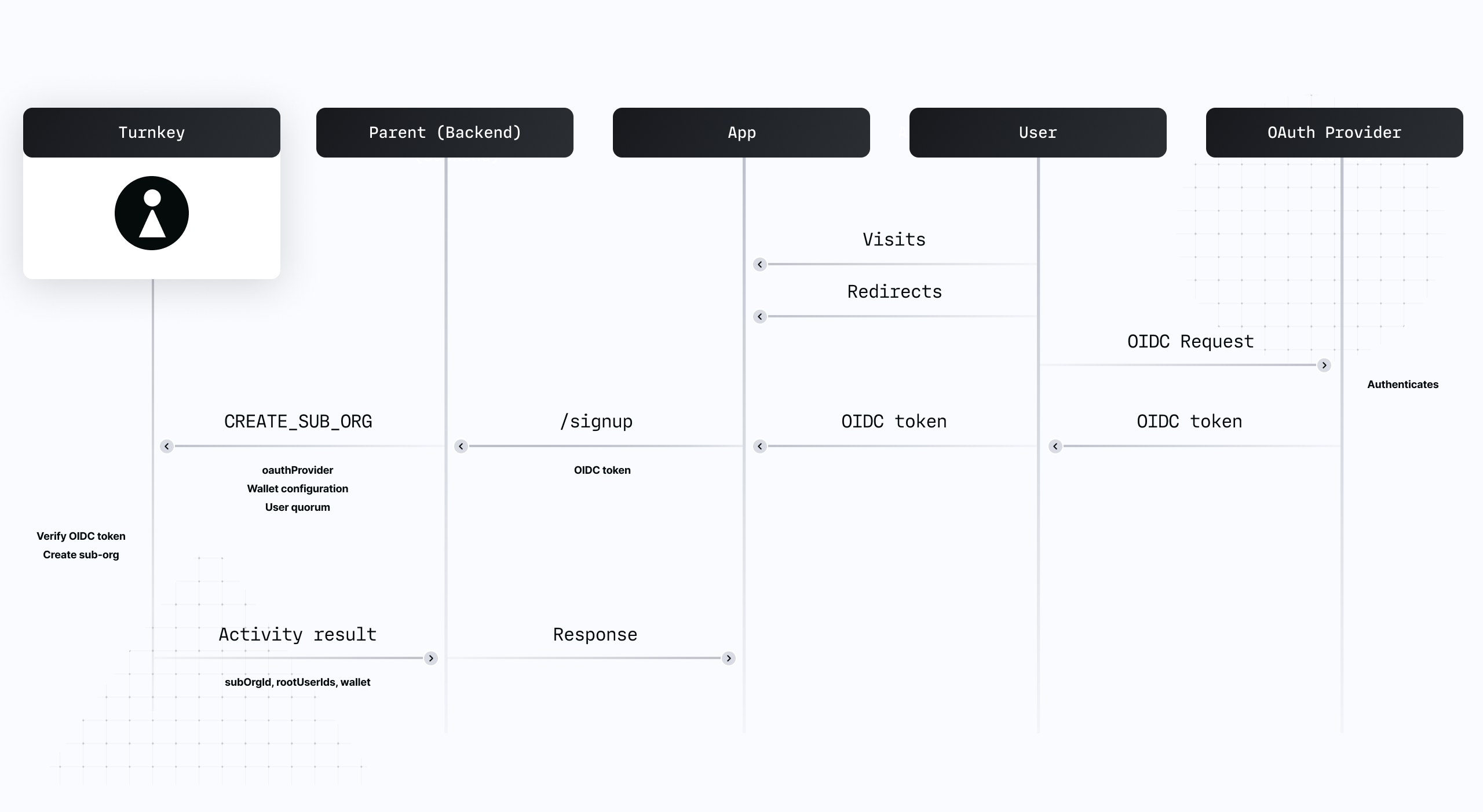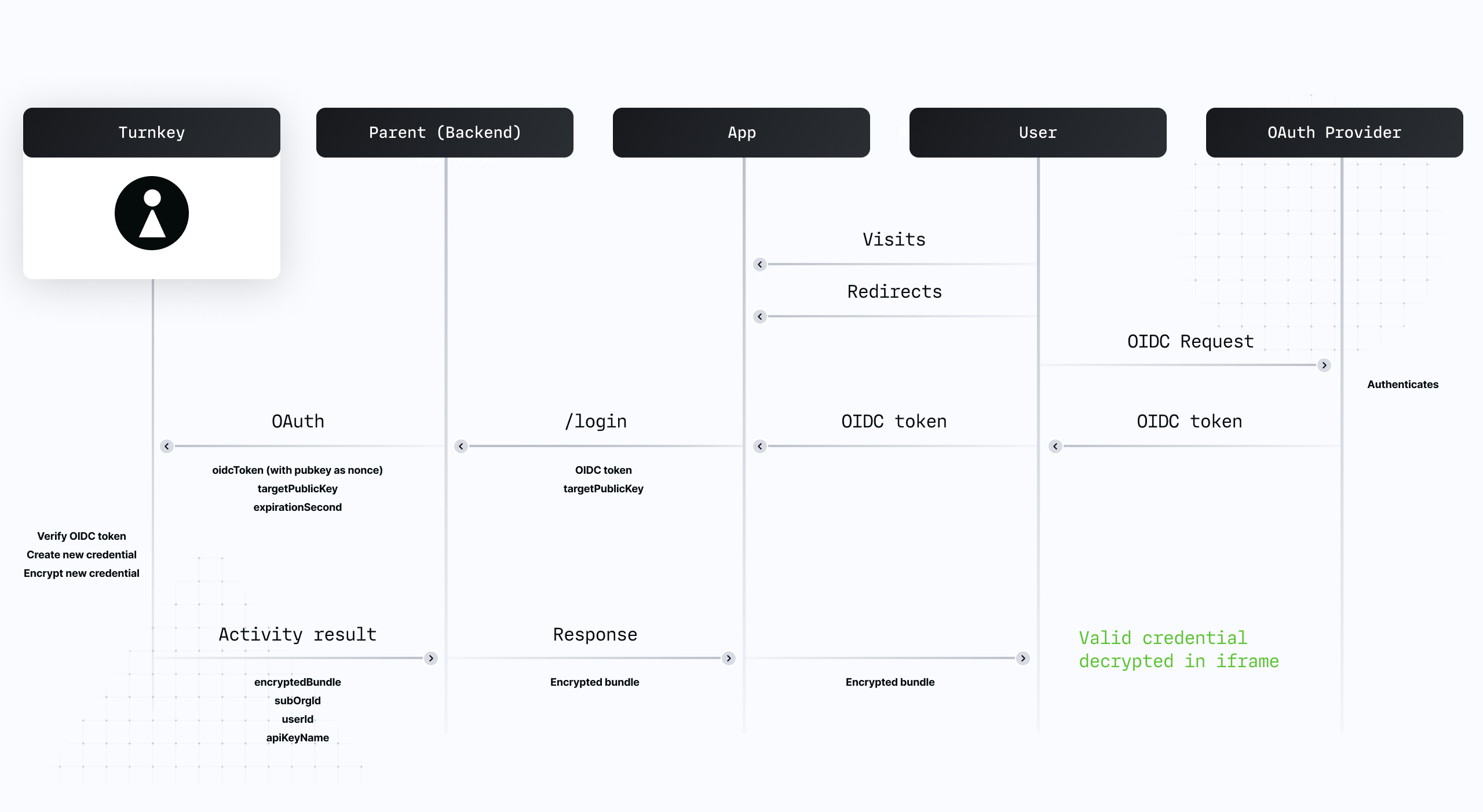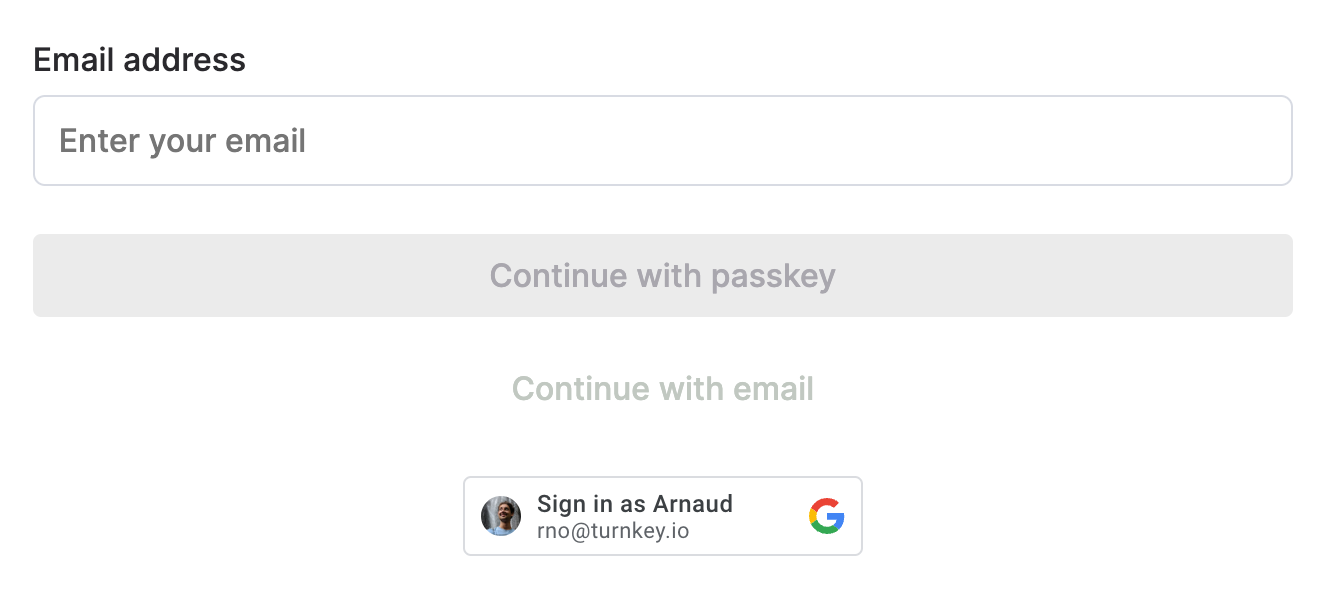OAuth
OAuth is a feature to authenticate users using OpenID Connect (OIDC) tokens. It is only available for sub-organization users.
Similar to email auth and email recovery, OAuth authenticates users who do not wish to handle API keys or passkeys directly. This makes it a great fit for onboarding users who have existing web2-style accounts (e.g. Google, Facebook) but do not know anything about cryptographic keys and credentials. An example utilizing OAuth for an organization can be found in our SDK repo here.
Roles and responsibilities
- Turnkey: runs verifiable infrastructure to create credentials and verify OIDC tokens
- Parent: that's you! For the rest of this guide we'll assume you, the reader, are a Turnkey customer. We assume that you have:
- an existing Turnkey organization (we'll refer to this organization as "the parent organization")
- a web application frontend (we'll refer to this as just "app" or "web app")
- a backend able to sign and POST Turnkey activities ("backend" or "parent backend")
- End-User: the end-user is a user of your web app. They have an account with Google.
- OIDC Provider: a provider able to authenticate your End-Users and provide OIDC tokens as proof. We'll use Google as an example.
OAuth step-by-step
Registration (signup)

- End-User enters the signup flow on the app, gets redirected to Google for authentication.
- Upon completion, the Parent's backend receives the OIDC token authenticating End-User.
- This token is used inside of a
CREATE_SUB_ORGANIZATIONactivity to register Google as the Oauth provider under the root user. - Turnkey verifies the OIDC token and creates a new sub-organization.
The user is now registered: a sub-organization under the parent organization has been created with a a root user, authenticated via an OAuth Provider. Concretely:
issueris set tohttps://accounts.google.comaudienceis set to<google-oauth-app-id>(your Oauth app ID)subjectis set<google-end-user-id>(the user ID ofEnd-Useron Google's side)
Authentication (login)

- End-User enters the login flow on the app, gets redirected to Google for authentication.
- Upon completion,
Parent backendreceives the OIDC token authenticating End-User. - This token is used inside of an
OAUTHactivity, signed by the Parent's backend. - Turnkey verifies the OIDC token and encrypts an expiring API key credential to End-User.
- End-User decrypts the credential.
The user is now authenticated and able to perform Turnkey activities.
OIDC token verification
All OIDC tokens are verified inside of Turnkey's secure enclaves.
We've designed a new secure enclave to fetch TLS content securely and bring non-repudiation on top of TLS content: our TLS fetcher returns a URL and the fetched content, signed by the TLS fetcher's quorum key. By trusting the TLS fetcher quorum key, other Turnkey enclaves can bring TLS-fetched data into their computation safely. Verifying OIDC token is the first computation which requires this!
To verify an OIDC token, other Turnkey enclaves receive the OIDC token as well as:
- the signed content of the issuer's OpenId configuration. OpenId configuration must be hosted under
/.well-known/openid-configurationfor each domain. For Google for example, the issuer configuration is ataccounts.google.com/.well-known/openid-configuration. This JSON document contains, among other thing, ajwksUrikey. The value for this key is a URL hosting the list of currently-valid OIDC token signers. - the signed content of the issuer's
jwksUri(e.g., for Google, thejwksUriisgoogleapis.com/oauth2/v3/cert). This is a list of public keys against which the secure enclave can verify tokens. Note: these public keys rotate periodically (every ~6hrs), hence it's not possible to hardcode these public keys in our secure enclave code directly. We have to fetch them dynamically!
With all of that, an enclave can independently verify an OIDC token without making outbound requests. Once the token is parsed and considered authentic, our enclaves match the iss, aud and sub attributes against the registered OAuth providers on the Turnkey sub-organization. We also check exp to make sure the OIDC token is not expired, and the nonce attribute (see next section).
Nonce restrictions in OIDC tokens
Our OAUTH activity requires 2 parameters minimum:
oidcToken: the base64 OIDC tokentargetPublicKey: the client-side public key generated by the user
In order to prevent OIDC tokens from being used against multiple public keys, our enclaves parse the OIDC token and, as part of the validation logic, enforce that the nonce claim is set to sha256(targetPublicKey).
For example, if the iframe public key is 04bb76f9a8aaafbb0722fa184f66642ae425e2a032bde8ffa0479ff5a93157b204c7848701cf246d81fd58f6c4c47a437d9f81e6a183042f2f1aa2f6aa28e4ab65, our enclaves expect the OIDC token nonce to be 1f9570d976946c0cb72f0e853eea0fb648b5e9e9a2266d25f971817e187c9b18.
This restriction only applies during authentication (OAUTH activity). Registration via CREATE_OAUTH_PROVIDER and CREATE_SUB_ORGANIZATION activities is not affected since these activities do not accept a targetPublicKey and do not return encrypted credentials as a result.
If your OAuth provider does not allow you to customize nonce claims, Turnkey also accepts and validates tknonce claims. This is an alternative claim that will be considered. Only one of (nonce, tknonce) needs to be set to sha256(targetPublicKey); not both.
OAuth vs. OIDC
OAuth2.0 is a separate protocol from OIDC, with distinct goals:
- "OAuth2.0" is an authorization framework
- "OIDC" is an authentication framework
We chose to name this feature "OAuth" because of the term familiarity: most Turnkey customers will have to setup an "OAuth" app with Google, and the user experience is often referred to as "OAuth" flows regardless of the protocol underneath.
Providers
Below, some details and pointers about specific providers we've worked with before. If yours isn't listed below it does not mean it can't be supported: any OIDC provider should work with Turnkey's OAuth.
Google
This provider is extensively tested and supported. We've integrated it in our demo wallet (hosted at https://wallet.tx.xyz):

The code is open-source, feel free to check it out for reference. The exact line where the OAuth component is loaded is here: ui/src/screens/LandingScreen.tsx.
The main documentation for Google OIDC is available here.
Auth0
This provider was tested successfully and offers a wide range of authentication factors and integration. For example, Auth0 can wrap Twitter's auth or any other "Social Connection".
In the testing process we discovered that Auth0 admins can manage users freely. Be careful about who can and can't access your Auth0 account: Auth0's management APIs allow for account merging. Specifically, anyone with a users:update scope token can call this endpoint to arbitrarily link an identity.
For example, if a Google-authenticated user (OIDC token sub claim: google-oauth2|118121659617646047510) gets merged into a Twitter-authenticated user (OIDC token sub claim: twitter|47169608), the OIDC token obtained by logging in through Google post-merge will be twitter|47169608. This can be surprising and lead to account takeover if an Auth0 admin is malicious. This is documented in Auth0's own docs, here.
AWS Cognito
The main thing to call out is the inability to pass custom nonce claims easily. To pass the hash of the end-user's iframe public key, use a custom tknonce claim instead.